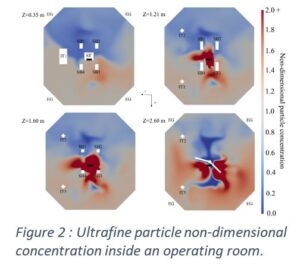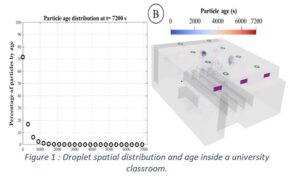Date: 7 novembre 2023, 11h-12h.
Titre du séminaire: Indoor air quality: innovative methodology for the analysis of airflow and mass transport
 Mini biographie de l’invité : I am an aerospace engineer. After a brief period on the LCA, I have done a PhD and a PostDoc at University of Naples “Parthenope” focused on the experimental and numerical analysis of the combined airflow-heat transfer and mass transport in indoor environments. Currently, I am working in the AEROTRACH research project, focused on the study of the droplet transport.
Mini biographie de l’invité : I am an aerospace engineer. After a brief period on the LCA, I have done a PhD and a PostDoc at University of Naples “Parthenope” focused on the experimental and numerical analysis of the combined airflow-heat transfer and mass transport in indoor environments. Currently, I am working in the AEROTRACH research project, focused on the study of the droplet transport.
Résumé :
The Indoor Air Quality (IAQ) in closed environments depends on the aerosol and gas concentrations in the air. There are several sources of aerosol and gas, such as envelope, furniture, humans and their activities. Given the importance of the topic, the present research has the aim of studying IAQ in indoor environments, mainly focusing on Operating Rooms (ORs) and university classrooms. In order to reach this goal, a detailed thermofluid dynamic model has been developed to reproduce the flow and thermal fields. Moreover, an ad-hoc Eulerian methodology based on the drift-flux model, including the effect of turbulent viscosity and settling velocity, has been developed using OpenFoam 8 and applied to the study of mass transport and deposition inside ORs with different geometries, Heating, Ventilation and Air Conditioning (HVAC) systems. A similar methodology, without the drift-flux phenomena, has been applied to study carbon dioxide (CO2) transport inside an actual university classroom. CO2 is used as a proxy to determine the IAQ level and ventilation efficiency. Experimental measurements have been performed in the classroom, in order to validate both the thermofluid dynamic and the CO2 fields. Lastly, the droplet transport has been studied, in the same university classroom and in a large university classroom, employing a Lagrangian particle tracking approach. The droplet concentration and age have been studied to analyse the risk related and the effect of the HVAC system and inlet airflow on the droplet transport, with the aim to reduce the contagion risk during a lesson. The proposed methodology and the obtained results can be considered as a guideline for the design of indoor environments, in order to improve the efficacy of HVAC systems and room layout, with the aim of increasing thermal comfort and IAQ and, at the same time, reducing health-related risk.
Mots clés : Mass transport, Indoor Air Quality (IAQ), Computational Fluid Dynamics (CFD), Aerosol, Indoor environments


Contact : Mustapha KARKRI Email : mustapha.karkri@u-pec.fr
